Here it is guys, all my top tips for herping thrown into one post. I hope it helps, but if there’s anything I haven’t covered get in touch via the Contact page.
Last updated on December 12th, 2022 at 09:03 am
Tips for herping
Herping involves gaining an understanding of the reptiles and amphibians you’re looking for, but also of the climate and ecosystem that they live in. With these tips, I hope to help you understand how the area and time of year can both affect your herping success. Now for the tips…
First of all, take it seriously. It can be a tough but rewarding hobby. In fact, you can make observations that are of genuine scientific interest – whatever your level of education.
From my childhood I can remember observing several species of reptile outside of their natural range, or even at much higher elevations than previously recorded. This was through luck and perseverance rather than genuine expertise!
Get the most out of your herping trips!
That said, these animals can be tricky at times, and personally I’ve had several disappointing herping trips over the years. Given the difficulty in locating some species, it is important to be informed about the tactics you will need to employ to make your trips as successful as possible. I’ve seen a few websites where people go herping all over the world, whenever they like and don’t seem to worry about things like time or money – and good for them, I wish I could!
When you have the possibility to go on far-flung or lengthy trips it really does up your chances of success. The fact of the matter though is that this isn’t how it is for most of us. So, what are we to do? Well, with this article I’m going to give as much in-depth information as possible on my own methods so that anyone, on any budget, can turn even just a week-long vacation into a successful herping trip.

Where to go Herping? Herp Species Richness vs Herp Population Density and Herp Species Diversity
The obvious answer to this question is “everywhere I can!”. For me though, projects at home (like an incubator full of python eggs) mean I can only travel once or sometimes twice a year. If this is the case for you too, it’s a good idea to let your interests guide where you travel to, so that you gain as much as possible out of each trip.
For example, my areas of interest are mainly Ball Pythons, Mediterranean biomes and North American colubrids. This really focuses my trips on the five areas of Mediterranean-type habitats (found in the Med. Basin, South Africa, Chile, California and Australia), the U.S.A. and Central/West Africa.
Out of these places, Portugal, Cyprus, Florida and Kentucky were the cheapest and most accessible – so that is where I started. If, on the other hand, you were a major turtle enthusiast then your best two destinations would be the south-eastern U.S.A. and the Ganges-Brahmaputra confluence area of India.
These two regions not only have the greatest number of turtle species (species richness) but also a high population density of many of those species – making them paradise for a Chelonia lover.
If you have very specific interests or goals, then you might be a little more limited. For example, if you wanted to find wild Gila Monsters, your only destination would be the American southwest as they live nowhere else.
Let’s get to grip with some herping terms
- Species richness: the total number of reptile and amphibian species found in an area
- Population density: how many individual herps are present
- Species diversity: both how many species of herps are present and how abundant each species is. Low species diversity = one or two very abundant species and the rest being very scarce → bad news for a herping trip!

I love the UK, but not for a herping trip…
Not all of us are specialists of course, but fortunately some destinations are simply great all round – I call them “sweet spots”. For me, a herping “sweet spot” is an area with relatively high herp species richness, decent herp species diversity and a high herp population density. It’s a good idea to aim for these areas when you can, so that you get as much as possible out of your trip, especially if you only have a week or two.
There are a few of these herping “sweet spots” around the globe – and contrary to popular belief they aren’t just on the equator. In fact, it is always a case of give-and-take with nature, and what I have found is that rainforests have a lower herp population density than the sweet spots, despite sometimes having a much higher species richness. By my definition South Africa, Australia, south-eastern/central U.S.A. and southern/north-eastern India are all sweet spots.
I could go to one of these locations and find more reptiles and amphibians in a week than I could in the heart of a rainforest, all the while spending less money and remaining within an hour’s drive from world-class medical facilities – see the attraction? Don’t get me wrong, if you get the chance to go to the rainforest you must take it, but don’t expect there to be creatures draped over every branch – it just isn’t like that.
Are there really snakes everywhere in the rainforest?
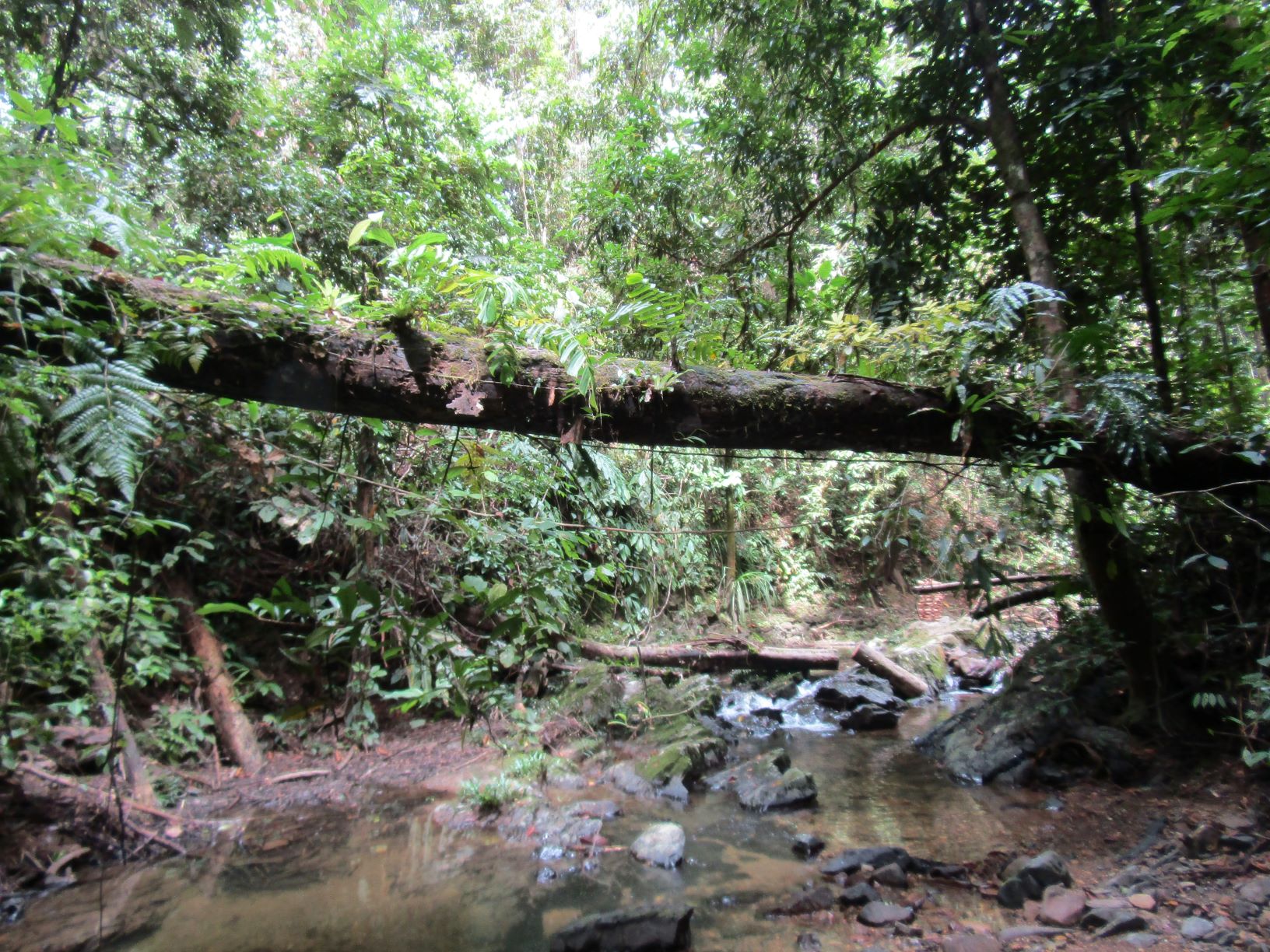
An area of riparian rainforest habitat that I visited in Borneo. Along that stream I found 2 turtle species, 5 lizard species, 5 snakes species, 1 caecilian species and around 20-30 species of Anuran.
This sounds great, but it was hard going and the population density of all non-Anuran species was low, equating to low herp species diversity. The most “tropical-rainforesty” thing I found was a tarantula if I’m honest.
All-in-all, I got similar results in Florida, but encountered a higher herp population density and more even herp species diversity. To be fair, I was feverish and hallucinating during some of my time in Borneo, but I was still expecting more success than I had!
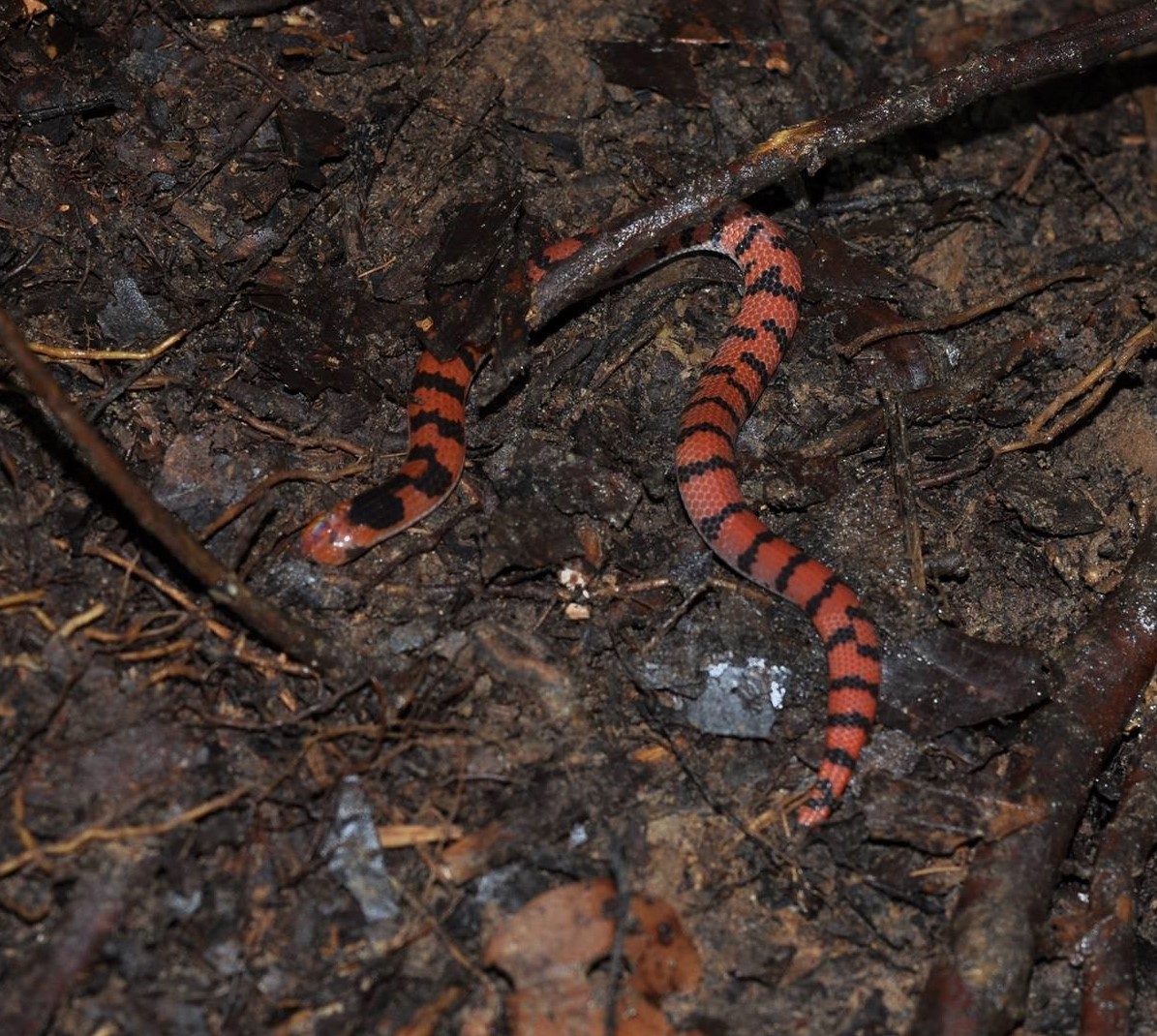
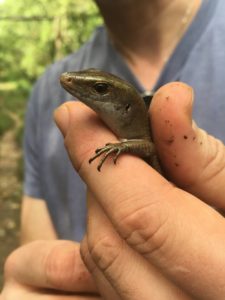
When to go Herping?
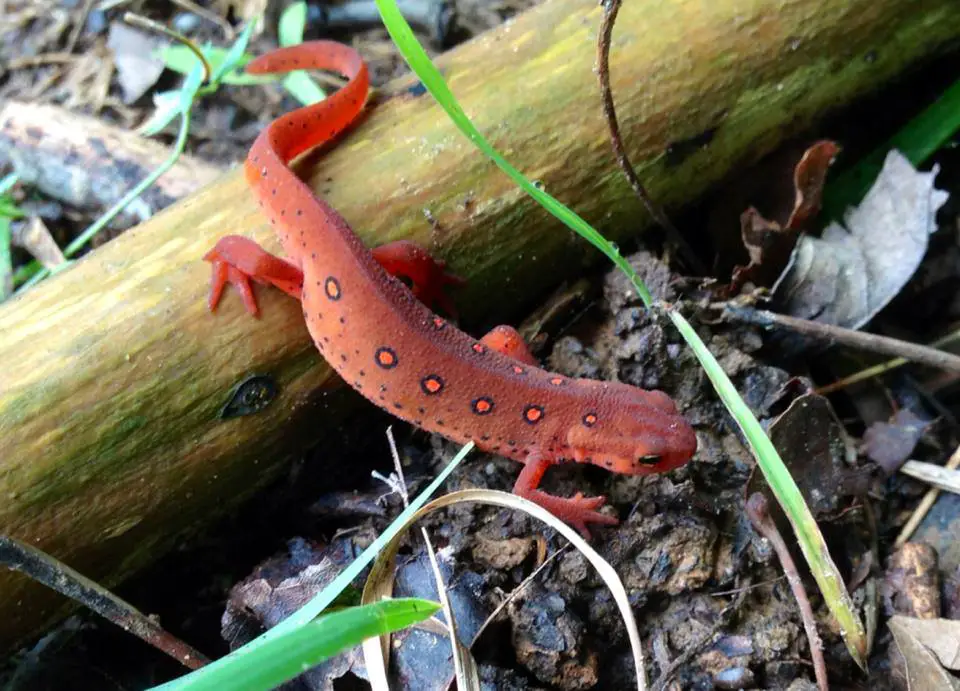
Tips for herping outside of the tropics
Once you have a location in mind, timing can be of major importance. As I mentioned before, some of the world’s best herping destinations are found either north or south of the equator. North of the Tropic of Cancer and south of the Tropic of Capricorn, seasonal changes play a major role in the ecology of reptiles and amphibians.
The most consequential of these changes can be the cool temperatures that sweep into places like northern Morocco during the winter months. The area still feels exotic, there are still palm trees, but guess what – it can occasionally get so cold it stops most native reptiles from being active. In my experience, it’s best to avoid winter trips to temperate/subtropical zones unless your destination is right on the edge of the tropics (like Florida or Georgia for example).
Likewise, the extended periods of summer heat and drought experienced in parts of the U.S. or Australia can make herping more difficult, not least because the heat really drains your energy. A lot of diurnal reptiles get uncomfortable when temperatures rise above 85F-ish (29C) and this forces them to go into a state of torpor underground or become crespuscular for a time (the big exception being desert-dwelling diurnal lizards).
Overall, I find the best time of year for herping outside of the tropics is spring. Temperatures are moderate, herps are out desperately trying to feed or breed, and the sparse vegetation makes them easier to spot. On a side note, reptiles seem to sense a storm coming and up their activity. On one such occasion I remember catching 21 garter snakes in two hours in Indiana!
At times like this, you can also encounter species like the Eastern Box Turtle (Terrapene carolina) crossing roads regularly.
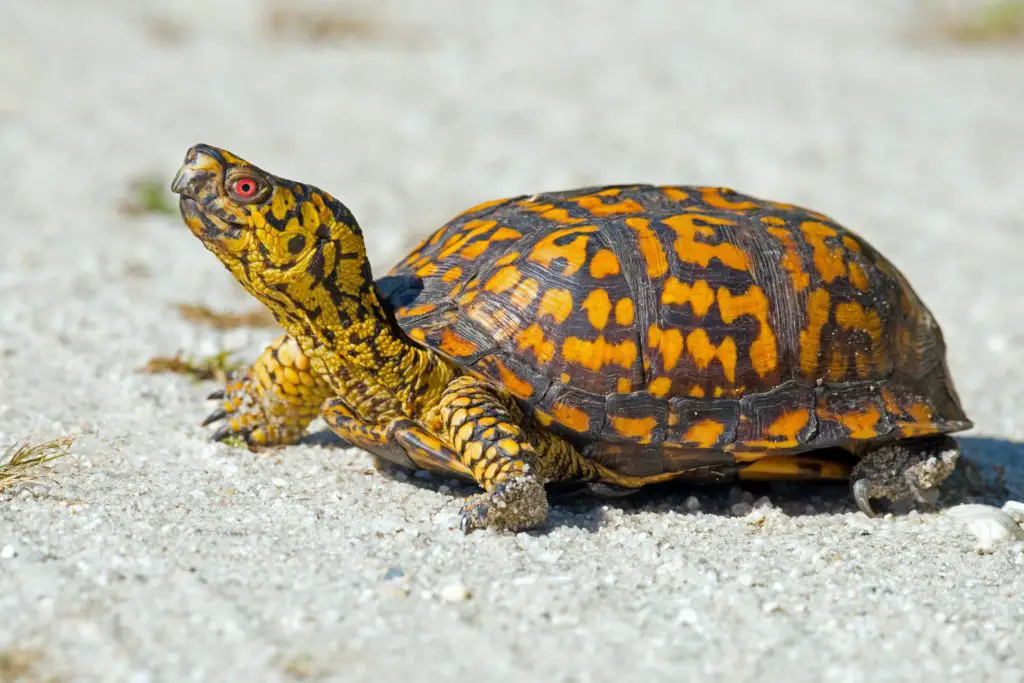
Tips for herping in the tropics
Though the tropics aren’t generally affected by the afore mentioned seasonal issues, they do deal with drought and dry seasons. Parts of the amazon basin are affected by drought at times, whereas areas of Bornean lowland forest seem to experience it fairly regularly, though not every year.
Drought is bad news for a herping trip because it drives many reptile species to burrow into the ground or under cover to estivate in a state of torpor. This helps to lower their metabolic rate and allow them to survive with less water. At these times amphibians will dig down even deeper, and you could be forgiven for thinking they had completely vanished!
On the other side of the scale, some tropical countries have a monsoon season, with cities like Mumbai in India receiving hours of heavy rain at a time. Obviously, it’s great for amphibians, and reptiles deal with it fine, but very heavy rain can easily ruin a week’s herping.
Purely for the fact that it makes everything slippery and even makes things harder to see, the monsoon rain is best avoided if you want a successful trip. In conclusion, if you go to the tropics then research the local weather patterns, paying close attention to when a monsoon or drought is likely to be taking place. A trip to the tropics can be a once in a lifetime event – don’t get caught out by a drought!
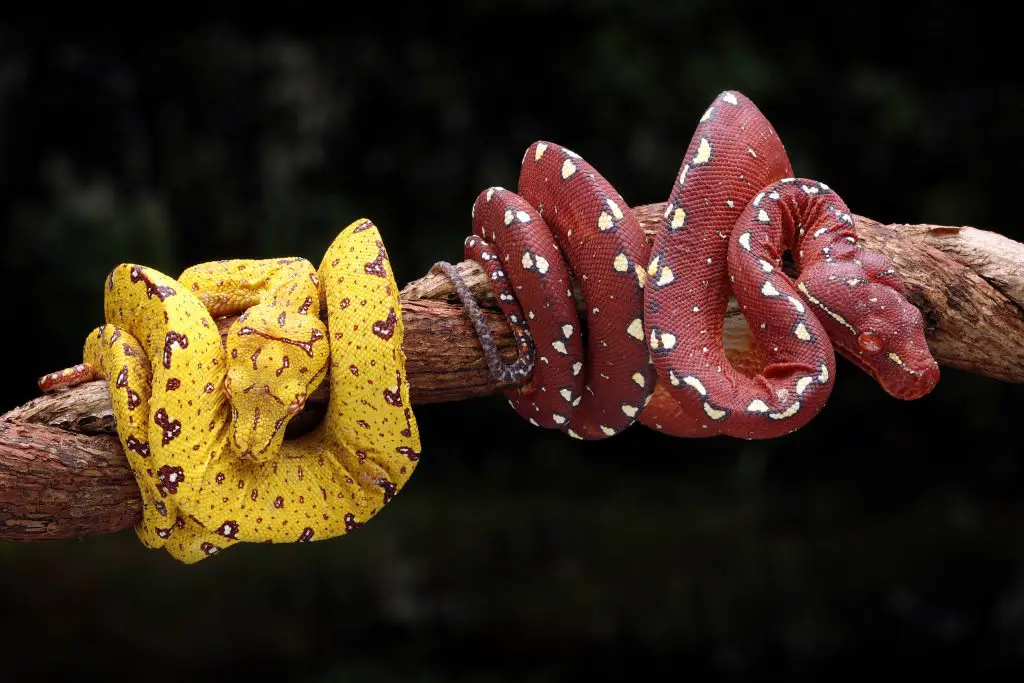
How to Herp
Herping methods broadly fall into two categories: active and passive. I’ll discuss both in a moment, but first let’s discuss how to choose the very specific areas of habitat that you should target. When you are exploring a region to find herps you should think about edges and islands. By edges I mean edges of specific habitat types.
The one time when a lot of reptiles and amphibians either break cover or become more visible is when they are at the edge of a patch of habitat. Just think about it, where would a snake be easier to spot? In an area of contiguous habitat that matches its camouflage, or at the edge of that habitat where it is halfway out in the open, trying to get some sun?
A good example of this is walking the banks of a river where water snakes and garter snakes are found. When basking on the edge of the water they are extremely visible when compared to if they were in the middle of the river, or in a field of long grass. The same will go for frogs and turtles at this location, they are easiest to catch when they are near the bank. What about lizards? Lizards are often visible basking at the edge of a forest or along fences at the edge of fields.
A coastal area is also an edge, as is an area where forest meets marshland. And the best edge of all? A road. Roads cut clean through huge areas of habitat and herps are extremely exposed when crossing them. In fact, road cruising is one of the most effective herp surveying techniques in many parts of the world. Be careful though, it has been banned in some areas.
What is an island?
Islands, on the other hand, can be useful for locating species that are absent from the surrounding areas. Here I’m also using the broad sense of the word island – not just the classic island in water sense. An oasis in the Sahara is an island, as is a tree in the middle of a large agricultural field. The top of a mountain is also an island when compared to the land around it.
Any of these land features can harbour different herps to the larger region within which they are located – sometimes even endemic species. A great example of this is of course the sky islands of Arizona. Actual islands in water, such as the Galapagos, can be even more interesting, not only harbouring endemics but also harbouring unusually high proportions of gigantic or miniature species.
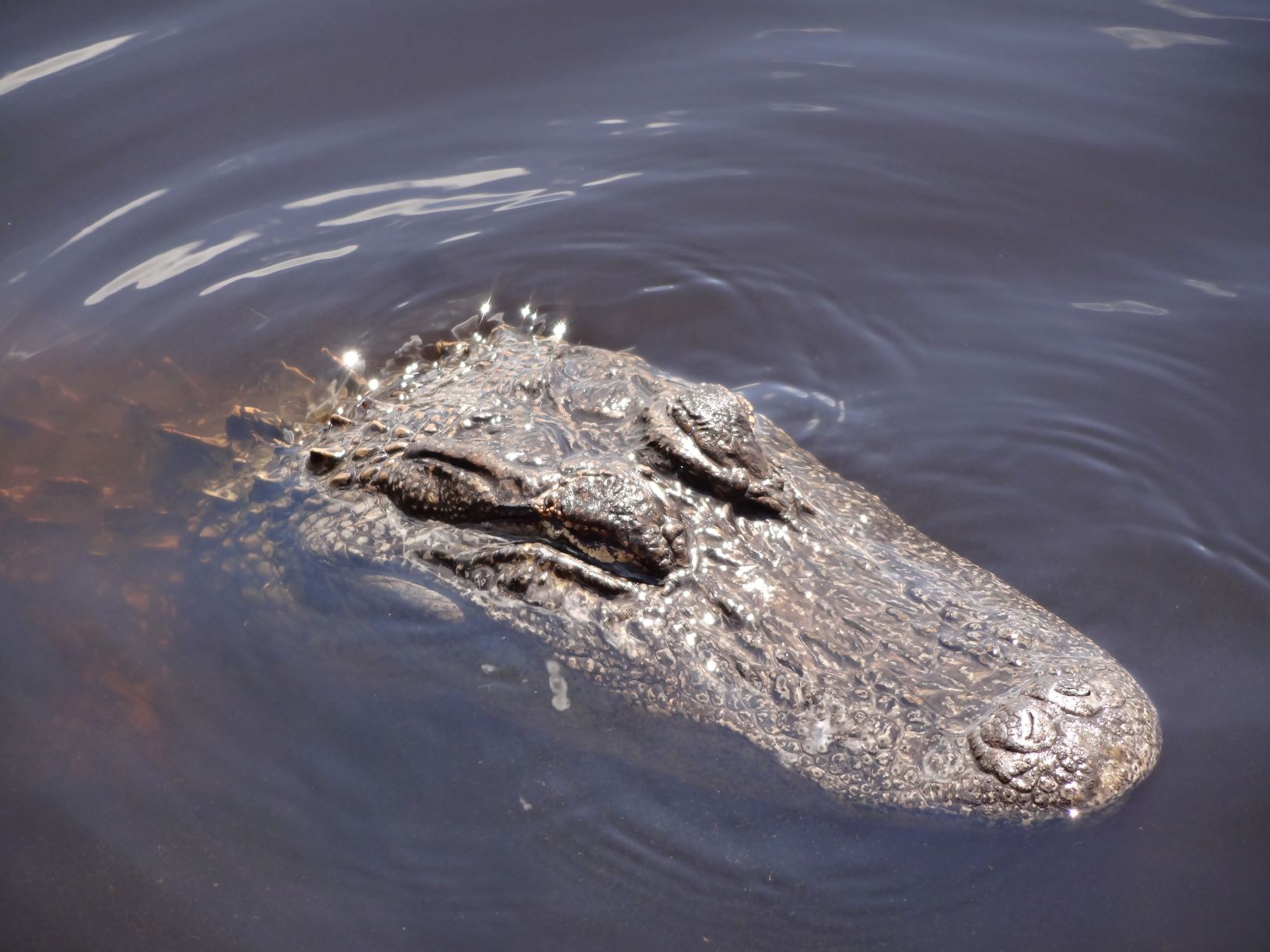
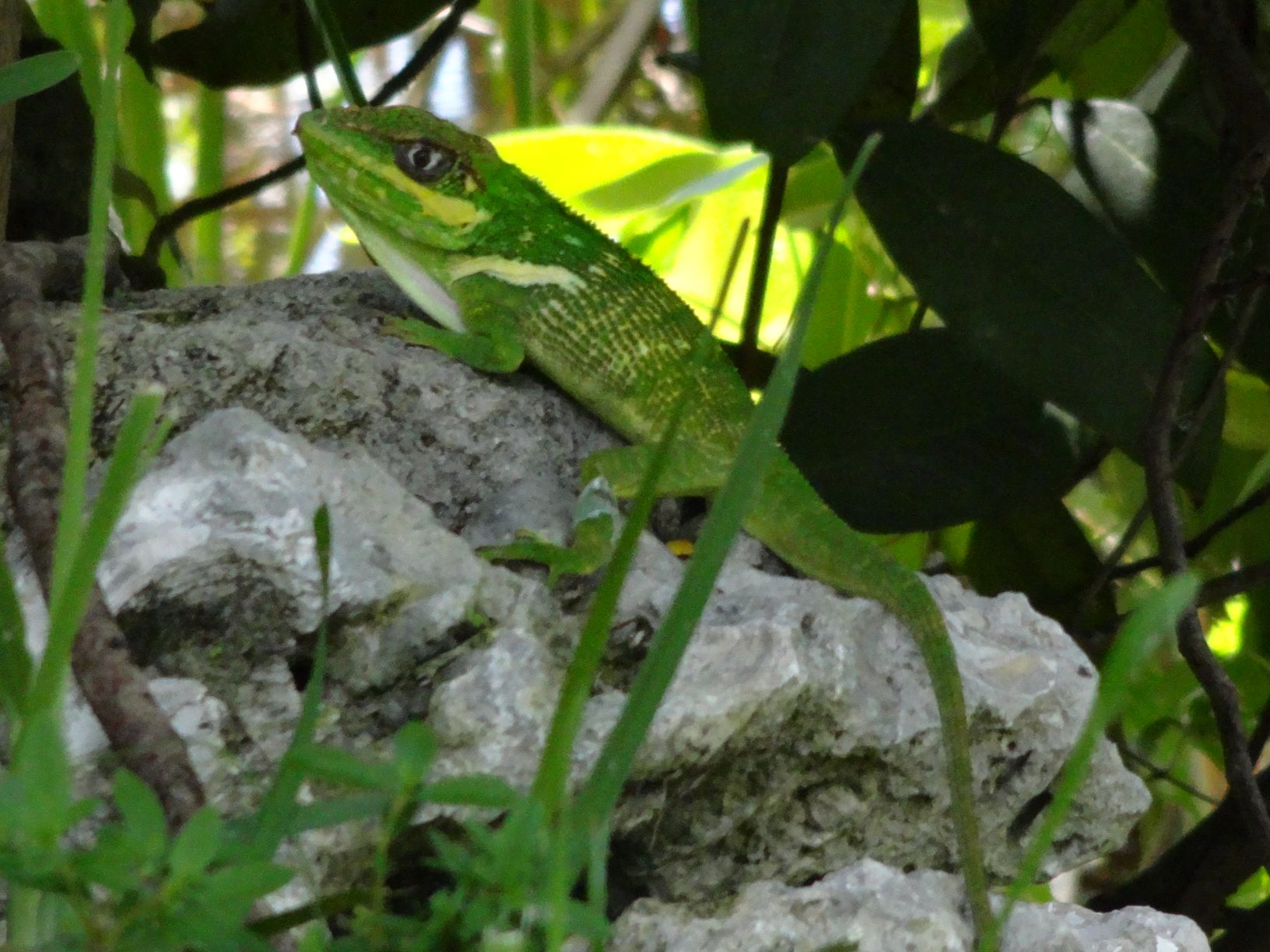
What are active and passive methods?
Earlier I mentioned passive and active methods. Passive methods are essentially surveying techniques that involve using your powers of observation to spot herps, whereas active methods involve actual physical work such as overturning rocks and other refugia.
Obviously, passive methods tend to be best for minimising disturbance to habitat and the risk of inadvertently injuring an animal. The problem is that passive methods don’t always work and are more time consuming. In fact, you would almost never see some animals unless you overturned a log, rock or other piece of refugia. Growing up in Indiana, I found more Eastern Red-backed Salamanders (Plethodon cinereus) than you could shake a stick at, but I literally never saw one without turning over a log.
The trick is to make sure that you remove the animal before replacing a piece of refugia exactly as it was, then allowing the creature to crawl back under. As always, don’t reach under a piece of refugia if venomous species are in the area, use a tool of some kind. Take a quick look at the table below to see which kinds of refugia harbour which kinds of herps.
Top types of refugia to check for reptiles and amphibians:
| Refugia type | Types of herp present | Best time to check |
| Tin and iron | Snakes of all kinds and sizes, skinks, toads | Early morning and during cool spells |
| Boards, wood, logs, dry bark | Snakes, skinks, toads, some treefrogs, some geckos | Early morning and during cool spells |
| Dry rocks/slabs | Small to medium sized snakes, skinks, agamas, blind snakes, amphisbaenians, Leopard Geckos | Morning or night-time if in full sun, anytime if in forest. |
| Coconut husk piles | Small snakes and lizards, caecilians, amphisbaenians, all amphibians. Red-eyed Crocodile Skinks (Tribolonotus gracilis) | Good to check at any time but only present in the tropics |
| Damp or rotting logs/bark | Juvenile or very small snakes – including coral snakes and young kraits, skinks, frogs and toads, caecilians, blind snakes, salamanders/newts, amphisbaenians | Good to check anytime. Scorpions, coral snakes and young kraits can be found under bark: caution is advised. |
| Plastic/tarpaulins | All types of reptiles/amphibians apart from chelonians are found under this but at lower frequency | Anytime, but results usually not as good as with other types of refugia |
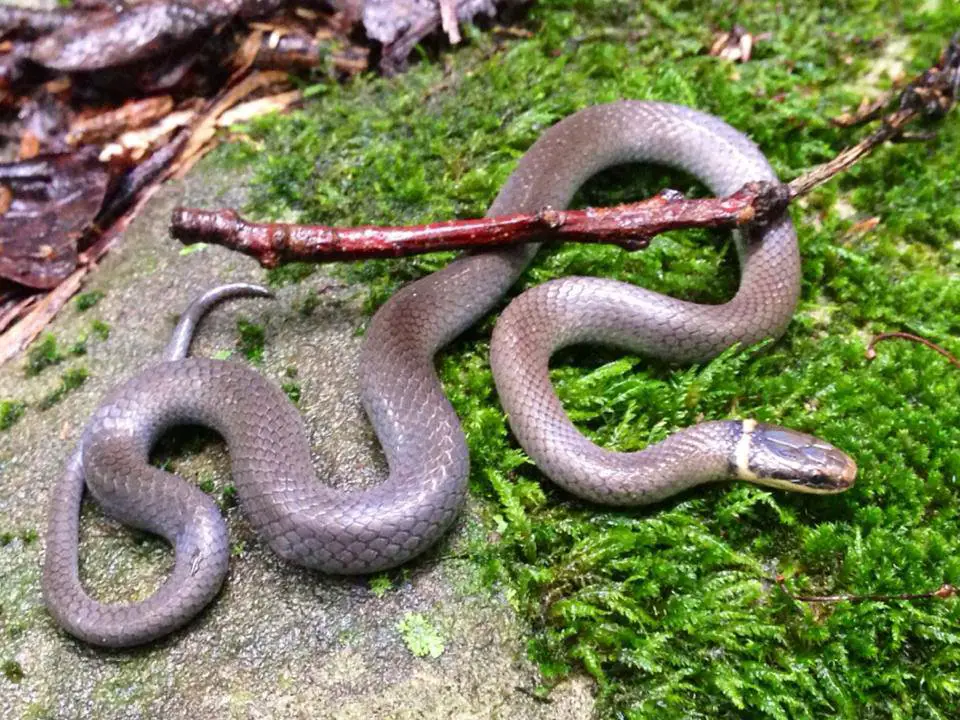
Other surveying methods
What about baby turtles and other aquatic herps? For these tricky customers dip netting is by far the best active method. If you decide to go dip netting, try to sweep the net down and towards you, so that you scoop it through the vegetation and back up towards your feet. Going through all the vegetation carefully can reveal some awesome surprises, from aquatic caecilians to tiny snakes and hatchling turtles. Make sure to put any vegetation back into the water after you’ve finished.
Herping for Specific Targets
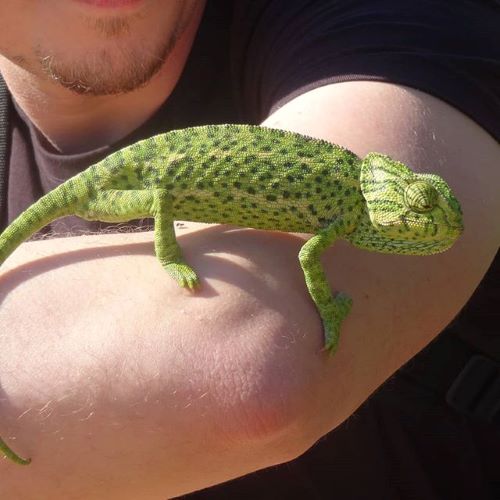
Research, research, research! If you’re looking for a specific target you must pay great attention to previous records of its sightings. Where has it been found? During what time of the year? In what habitat? What was the weather like at that time? When is its mating season? Was it found in a tree, if so, what species of tree and how high up? If you’ve seen a photo of a specimen found under a board, what was it like under that board? Was it damp or dry?
Building yourself a picture of the exact circumstances that led to previous sightings of the animal will maximise your chances of success.
Do your homework first!
If you don’t do your research then a few days herping can turn into a wild goose chase, and its more than a little disheartening. These days your best bet for getting this kind of information is through online herping forums, where members exchange information and records of their herping adventures. Generally, these people are extremely helpful if you come across as someone who wants to observe herps without harming them.
Don’t be Fooled by Range Maps!
A major error of judgement that I used to make as a kid was blindly believing range maps. There I was, wandering around the marsh behind my estate looking for Massassaugas because hey, the range map in my trusty field guide told me they were found throughout my whole county! This of course relates to what I have said in the previous paragraph, that actual sightings of an animal are the most powerful proof of its occurrence in an area.
Nonetheless, I still have people say to me “this species of snake must be around here because such and such field guide says so!”. The thing is, range maps, as presented in field guides, do come from actual sightings – but the area between the sightings is included in the distribution. So, if there were ten sightings of an animal, evenly dotted around a particular county, then that whole county could be deemed an area where the animal is found – and show up as a solid area of its distribution.
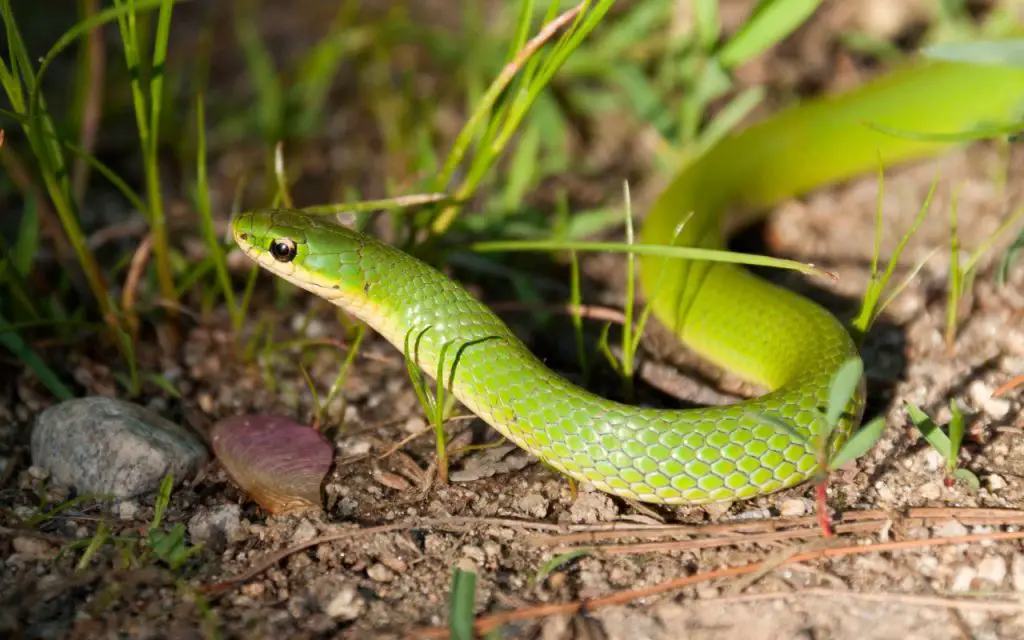
In the end I did find one Massassauga, but I never found quite figured out the local distribution of Smooth Green Snakes. The most frustrating part about this was that I had friends find them who literally lived 10 miles from me!
It just goes to show, you can’t always trust range maps.
Watch out for “patchwork” distributions
The problem is that many species don’t occupy whole areas; they tend have more of a patchwork distribution, missing out a 4 square mile area here or a 500 sq ft field there… In some areas, absolute assholes might have collected most of them for the pet trade and now they are on the edge of local extinction! So, your best bet is to use range maps and field guides as a good general indication of the presence of a species, but to use recent sightings with photographic evidence as absolute proof.
Let’s take a look at a few maps I’ve drawn that use an imaginary scenario to illustrate the point. They are exaggerated and depict the range of a completely made-up animal: the “Indy Snake”. Though they may seem far-fetched, they depict a scenario that has played out a few times over the last fifty years.

A. The official range of the Indy Snake as told by a field guide. “This big, aggressive species is found throughout the deciduous forests of southern Indiana” it says… The range map was generated using recent sightings, museum records and projected range based on suitable habitat. That said, the field guide hasn’t been updated in twenty years – uh oh!
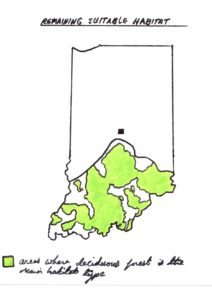
B. Actual areas of deciduous forest in southern Indiana. Unfortunately, laws on land use have changed over time, new projects have arisen, and cities have expanded. A third of the deciduous forest the Indy Snake calls home has been destroyed. Better avoid the deforested areas if we want to see one…
Getting that sinking feeling yet?
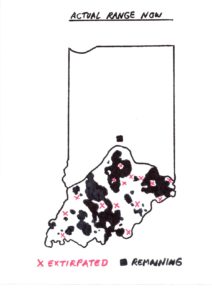
C. Areas where the Indy Snake has avoided extirpation. Thank God the Indy Snake still has two-thirds of its deciduous forest habitat to live in, right? Well, no. As we mentioned before, local cities and their human populations have expanded, meaning those remaining deciduous forests are full of hikers, mountain bikers, hunters, roads and vehicles.
Not only is the Indy Snake sensitive to disturbance when reproducing, it is also large and perceived as aggressive, just like the field guide told us. The result of this is that the species has now been extirpated by humans in many of the forests that were its safe havens.
So what have we learnt?
The range of the Indy Snake has been reduced by over 50% in the last 30 years, and 40% since our field guide was last updated! A distribution map can only tell you so much, and if you rely on that alone then you may never find this beautiful species. Up to date range maps published by government bodies and some websites can be a little better, but still include ‘projected range’.
Go to the forums and check in with people on the ground if you want to increase your chances!
Factors that Maximise Herping Success
Putting out tin and wood as artificial refugia is by far the best method for results. That said, some animals take weeks or months to begin exploiting these, so if you’re only on vacation for a week you won’t have enough time for this to be an effective method. In a situation like that it is good old-fashioned hard work and common-sense that will pay off.
First of all, be prepared. Take a flashlight, a dipnet and anything else that could come in handy during the day or night. When you are sufficiently prepared, and you’ve done your homework on the area, that is the common-sense part taken care of. As for the hard work part this translates into time and effort, and these factors can make all the difference – unless you’re very lucky. Let’s use a theoretical graph as an example…
The following graph shows the number of target species found and time spent herping in total days. Notice the point at which 50% of our targets have been found, a milestone I like to reach to consider a trip a successful.
Don’t expect great results without a lot of time and effort!
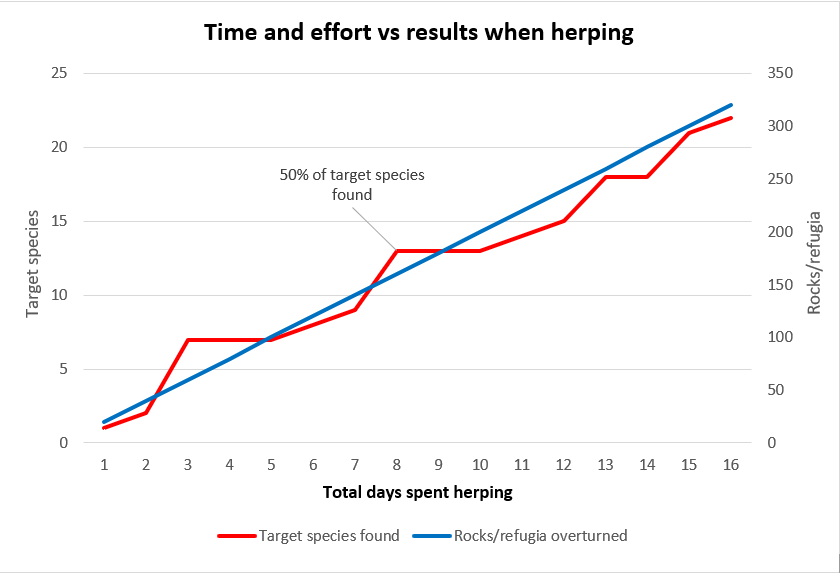
You can see from the graph that the number of species found increases in line with the number of days spent herping, with 50% of the target species being found after 8 days in our imaginary scenario. Not only that but the number of species found correlates strongly with the number of rocks/refugia overturned, this being representative of the effort aspect. In a nutshell, more time and effort = more species found!
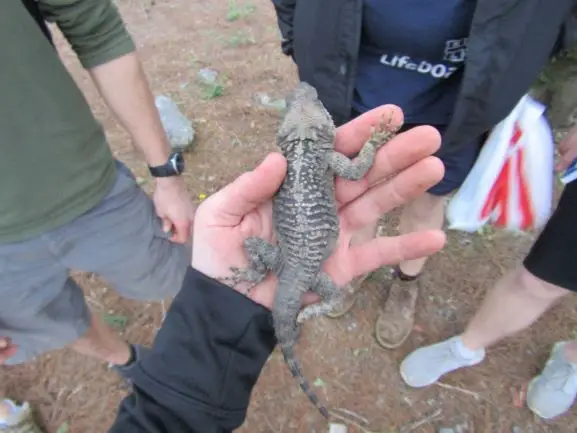
I was having an awful day when I found the Starred Agama (Stellagama stellio cypriaca) above. I was tired, it was freezing cold, and when I finally found him he was under some huge rocks that were a nightmare to put back correctly! Still, I put in the work and in retrospect it was worth it.
Mix things up to increase your chances
After time, effort, preparedness and research, there is one other key element for success: variety. Strive to survey as many different areas as possible throughout your stay and this will help overcome the issue of patchwork distributions that I mentioned in section 6.
Any type of transport will help with this element. Rent a car if you are old enough and its legal, or a bike if not. If none of these options are available, then check out the local bus and train routes. On several occasions, being more mobile and sampling a variety of locations has made a huge difference to my trips.
Dressing Appropriately
Dress for the weather, dress for the culture, and dress for safety. In places like Venezuela or Colorado, big rattlesnakes mean protective gear for your legs is genuinely a worthwhile investment.
In other parts of the world it is important for women to cover their arms and legs to respect local culture. Keep the locals on your side – you never know when you might need help from them!
I’m not going to go into to detail about how to dress for each climate etc, because you aren’t babies. That said, the two worst things that have happened to me when herping have been bad rubbing from uncomfortable hiking boots, and constantly being wet from not bringing enough waterproof clothing.
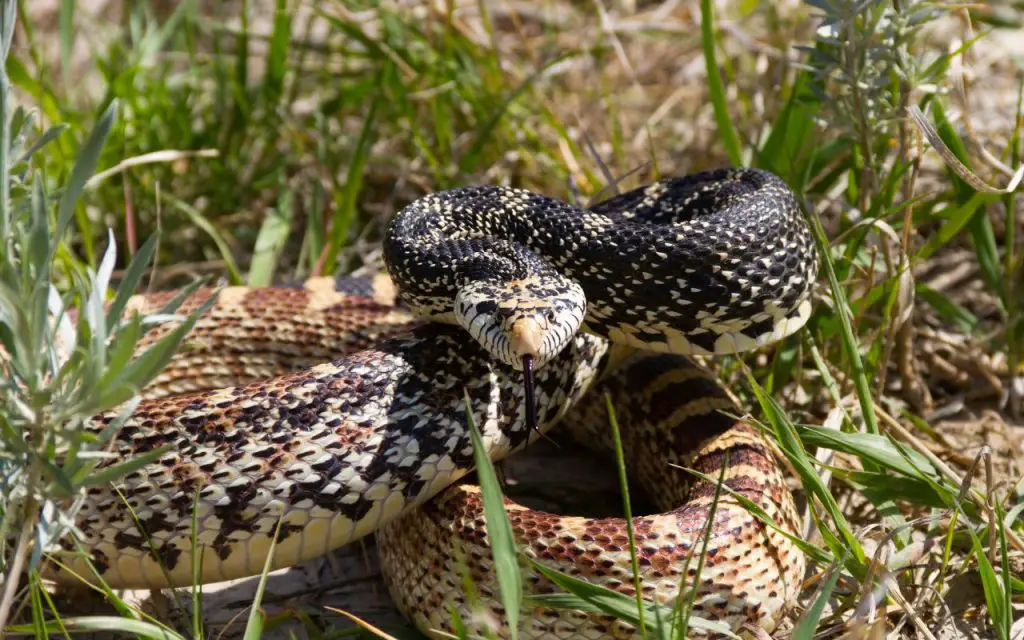
Protecting Animals, Habitats and our Image While Herping or Keeping Reptiles
Up to this point I’ve talked about herping as an enriching and positive hobby – and I stand by this. This isn’t always how it is perceived though, and the fault lies with herpers who haven’t treated animals and habitats with enough care and respect.
Back in the late 90’s or early 00’s (my memory might be slightly off) there was a big Grey-banded Kingsnake craze (Lampropeltis alterna), and these west-Texas colubrids were selling for $500. Almost overnight, certain herpers were turning into collectors, and a few of them really threw their moral compasses in the trash.
People were using crowbars to break apart rock crevices and making no effort to repair the damage to habitat. The same thing started happening in southern California when Rosy Boas (Lichanura trivirgata) became popular. It was a perfect storm for habitat destruction and over-collection. Unfortunately, this scenario was repeated in many areas across the globe, with herpers sometimes doubling up as collectors and harvesters, tarnishing our reputation with animal rights charities and conscientious naturalists alike.
Charities aren’t so charitable when it comes to reptile enthusiasts…
Skip ahead to 2020, and herpers and herpetoculturists are being targeted by organisations that want herping and the keeping of all reptiles and amphibians to be banned. These organisations have the ultimate goal of stopping us from having pets other than dogs or cats, so they target reptile keepers first as they know that we’re considered a bit “weird” and legislators are more likely to discriminate against us in exchange for votes.
The sad truth though is that dogs and cats, even in proportion to their captive populations, are much more often victims of abuse and neglect – they are truly in need of help in many parts of the world. The problem is that these animal “charities” know well that dogs and cats are old news, and really aren’t going to generate them a lot of income from publicity.
So how’s this playing out?
In Spain, Ball Pythons, California Kingsnakes and Savannah Monitors are now banned under the pretext that they are potentially invasive species. In Florida, Tegus have now been banned, and New York is now looking at banning shipping all animals.
Over here in the UK, an animal charity has been lobbying the government to push for a ban on Ball Pythons with the help of some European herpetologists.
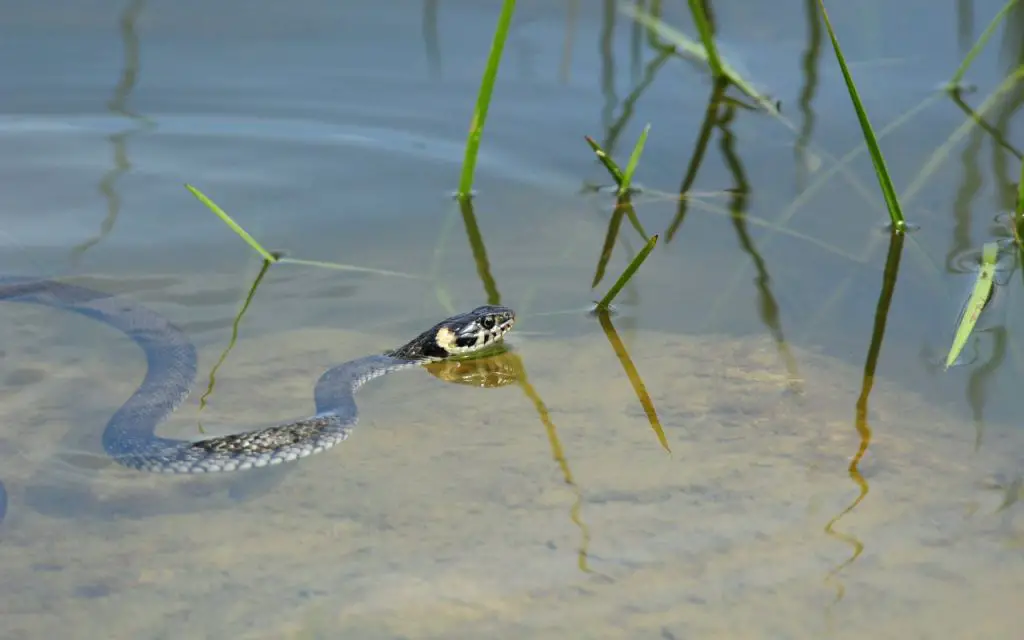
Your government is being lobbied to ban you from keeping reptiles
According to some sources, a EU-wide ban on Ball Pythons has also been discussed by some low-level politicians and a group that is lobbying for it. This would result in huge media coverage for the “charity” and keep their profits flowing nicely.
One organisation has even gone as far as to use the Youtube videos and Facebook profiles of Ball Python breeders in their articles, without any consent. In these articles they use slight of hand, magician style tricks to incriminate us, such as photographing display cases and implying that they are full-time enclosures for adult snakes.
Campaigners have also succeeded in making herping illegal, even just for photography, in several regions of the world.
Banning herping and reptile keeping is becoming a big-money business!
Let’s be honest though: do we think that all of these “charities” started targeting us for no reason? Of course not! They are semi-conscientious people, who want to protect the rights of animals (whilst furthering their careers and making some serious cash).
The problem is that some of us made ourselves into a target through bad behaviour! The sooner we understand that we must maintain an extremely high standard of behaviour, even when just photographing herps – the longer our hobby will last.
Here are a few guidelines that can help protect our hobby from bad press and hopefully improve our image:
1. Don’t ever collect wild animals as pets, it’s just not necessary anymore. My pets have been bred in captivity for generations and are no longer wild – this is how it should be.
2. Make sensible decisions about whether to handle an animal or not. If an animal is in the road or on a path, chances it will get killed if you don’t move it – and I always do. If the animal is resting far from people then sometimes it’s best to leave them be, no matter how tempting it is to pick them up.
3. Respect local and national laws, as well as private property. If you’re not allowed to road cruise an area then don’t, and if you want to look for animals on private property then make sure you get permission.
4. When dealing with law enforcement be polite, open and honest. I’ve been stopped, searched or detained about 8 or 9 times now and what I mention above is your only way out of the situation. Get cocky and it will be prolonged.
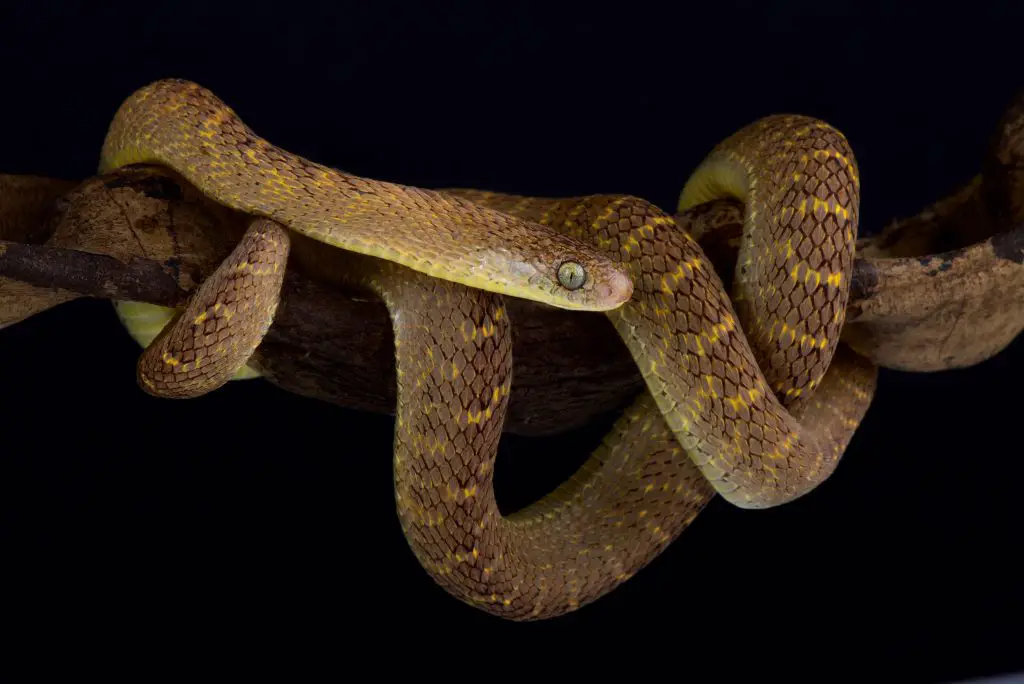
Education is the key
5. Always make an effort to educate people. In the long run, education is the key to conservation, not enforcement.
6. Be careful who you talk to about reptiles, you might get more than you bargained for. Recently a lady attending a reptile show with her daughter was asked by some “documentary makers” if they could film her daughter holding a snake. She agreed, proud that her daughter had an interest.
It later turned out the people filming were from an international charity that campaigns against keeping ball pythons. Her young daughter was then portrayed as an unwitting animal abuser. I saw the comments the lady in question made after the film was published and she wasn’t impressed that her and her child had been manipulated in such a way.
Don’t tease reptiles to show off!
7. Don’t tease wild reptiles to show off! This one is for the guys as I’ve yet to see a woman do it. I’ve seen other Herpetologists tease cornered snakes into striking and it is cruel, there’s no excuse. If you have to catch a snake and move it for its own good then do, you will do it quickly if you have a conscience.
If the snake is already cornered and terrified don’t taunt it and draw it out longer. It doesn’t make you look tough or increase your height. It won’t make you more attractive to women or more intimidating to other men. It just makes you look like a bit of an asshole.
8. Stop talking about how “deadly” a snake is. Another one for the guys unfortunately. Literally no animal is deadly if you give it space. Not only that but snakes are incredibly easy to handle with hooks, there isn’t a lot of bravery involved.
Posting photos of a snake you’re holding with a 3ft snake hook and saying how deadly it is impresses no one. It’s like holding a cactus out on the end of a shovel and saying how many spikes it has – the only difference is that you’re doing it with a snake because you know people are afraid of them and hope it will give you some man points. All you’re doing by referring to snakes as “deadly” is making people more afraid – and more likely to kill them.
9. Leave every single bit of refugia intact and back where it was. I mean EXACTLY where it is, they are never same again if not. Don’t destroy precious habitat – easy!
Safety, First Aid and Snakebite

I’m going to keep this section short for one reason – I am in no way qualified to teach you about first aid, or perhaps even common sense. In fact, I’ve broken at least five bones doing stupid things and have a plate and screws in my heel to this day! Notwithstanding, there are some golden rules that are obvious even to me. They are the following:
1. Do a course in first aid! They are cheap, or even free, and can literally mean the difference between life and death in the case of an accident.
2. Spend the extra £/$20 on decent first aid kit and make sure it contains a pressure bandage. Some antihistamines won’t go amiss either.
3. Research emergency snake bite treatment from a REPUTABLE source. People selling “amazing 100% effective snake bite suction kits” on the internet = NOT REPUTABLE. The World Health Organization (WHO) = REPUTABLE. Other reputable sources include the militaries of countries where snake bite occurs, the US Navy being a good example.
The phone is mightier than the sword
4. Always have a phone on you with emergency numbers saved to it. Other than good first aid, it is a phone call that will save your life in the case of a severe envenomation. Even if you can get a hold of antivenom, could you really handle it if you injected it into a companion and they went into anaphylactic shock? I certainly couldn’t. If you are within an hour or two of a hospital a phone is actually a better bet than antivenom.
Just take a phone that will work on the local networks and save the appropriate emergency numbers to it. If you’re going somewhere very remote, then get a satellite phone – you’d be surprised how affordable they are becoming. With proper first aid most people survive snake bite, but only after subsequent hospital treatment. Having a phone and getting to a medical facility really is the be-all and end-all.
5. Don’t put your hands into dark places and keep your eyes in front of you. Looking where you’re going helps avoid walking into a low-hanging branch with a pitviper on it or stepping on a basking snake. Likewise, using tools to overturn refugia or artificial cover, rather than reaching under them, helps avoid being bitten on the fingers.
6. Trust your gut. If you’re tempted to handle a potentially dangerous animal and get that bad feeling in the pit of your stomach, you must always trust it. Same goes with places, situations and people – your gut instinct doesn’t lie.
Relax and Enjoy Yourself!

Did I find a lot of animals at the beach? Honestly, no. But I did have a good time!
Not finding your target species? Well don’t sweat it! One thing I’ve learnt is that if you follow all of the above tips (and put in some work) then you will find something. In fact, a lot of times you’ll be looking for one animal and find something else that was completely unexpected.
Moreover, exploring is enriching no matter how successful a trip is in terms of herping. Experiencing new habitats, scenery and food are always worth it. So relax, enjoy yourself, and make the most of it!
I hope this article has been informative, please get in touch with your herping stories and photos!

